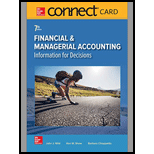
1.
To compute: (a)
1.
Explanation of Solution
(a)
Formula to calculate current ratio is,
Current ratio of B Company:
Given info,
Current assets are $155,440
Current liabilities are $61,340
Substitute $155,440 for current assets and $61,340 for current liabilities.
Thus current ratio is 2.53.
Working notes:
Likewise, current ratio of K Company:
Thus, current ratio is 2.55.
(b)
Formula to calculate acid test ratio is,
Acid test ratio of B Company:
Given info,
Cash is $19,500.
Accounts receivables are $37,400
Current liabilities are $61,340.
Substitute $19,500 for cash, $37,400 for accounts receivable and $61,340 for current liabilities.
Thus, acid test ratio is 0.93
Likewise, acid test ratio of K Company:
Thus, acid test ratio is 0.98.
(c)
Formula to calculate accounts receivable turnover is,
Accounts receivable turnover of B Company:
Given info,
Net sales are $770,000.
Accounts receivable is 37,400.
Substitute $770,000 for net sales and $37,400 for accounts receivable.
Thus, accounts receivable turnover is 20.59.
Likewise, accounts receivable turnover of K Company:
Thus, accounts receivable turnover is 15.33.
(d)
Formula to calculate inventory turnover is,
Inventory turnover of B Company
Given info,
Cost of goods sold is $585,100.
Inventory is $84,440
Substitute $585,100 for cost of goods sold and $84,440.
Thus, inventory turnover is 6.93.
Likewise, inventory turnover of K Company:
Thus, inventory turnover is 4.77
(e)
Formula to calculate day’s sales in inventory is,
Day’s sales in inventory of B Company
Given info,
Inventory at the end of the year is $84,440
Cost of goods sold is $585,100
Substitute $585,100 for cost of goods sold and $84,440 for inventory at the end of the year.
Thus, day’s sales inventory is 36 day
Likewise, day’s sales in inventory of K Company:
Thus, inventory turnover is 76.46 days
(f)
Formula to calculate day’s sales uncollected is,
Day’s sales uncollected of B Company
Given info,
Accounts receivable is $37,400.
Net sales are $770,000.
Substitute $37,400 for accounts receivable and $770,000 for net sales.
Thus, day’s sales uncollected are 17.73 days.
Likewise, day’s sales uncollected of K Company:
Thus, day’s sales uncollected is 23.80 days
2.
To compute: (a) profit margin ratio (b) total assets turnover ratio,(c) return on total assets ratio (d) return on common
2.
Explanation of Solution
(a)
Formula to calculate Profit margin ratio is,
Profit margin ratio of B Company
Given info,
Net income is $162,200.
Net sales are $770,000.
Substitute $162,200for net income and $770,000for net sales.
Thus, profit margin ratio is 21.06%.
Likewise, profit margin ratio of K Company:
Thus, profit margin ratio is 24%.
(b)
Formula to calculate total assets turnover ratio is,
Total assets turnover ratio of B Company
Given info,
Net sales are $770,000.
Assets in the beginning of the year are $398,000.
Assets at the end of the year are $445,440.
Substitute $770,000for net sales and $398,000for assets in the beginning of the year and $445,440 at the end of the year.
Thus, total assets turnover ratio is 1.83.
Likewise, total assets turnover ratio of K Company:
Thus, total assets turnover ratio is 1.90
(c)
Formula to calculate return on total assets ratio is,
Return on total assets ratio of B Company
Given info,
Net income is $162,200.
Assets in the beginning of the year are $398,000.
Assets at the end of the year are $445,440.
Substitute $162,200 for net income and $398,000for assets in the beginning of the year and $445,440at the end of the year.
Thus, return on total assets ratio is 0.38
Likewise, return on total assets ratio of K Company:
Thus, return on total assets ratio is 0.45
(d)
Formula to calculate return on common stockholder’s equity is,
Return on common stockholder’s equity of B Company
Given info,
Net income is $162,200.
Common stock in the beginning of the year is $180,000.
Common stock at the end of the year is $180,000.
Substitute $162,200 for net income and $180,000 for common stock in the beginning of the year and $180,000 at the end of the year.
Thus, return on common stockholder’s equity is 90.11%.
Likewise, return on common stockholder’s equity of K Company:
Thus, return on common stockholder’s equity is 102.14%.
(e)
Formula to calculate price earnings ratio is,
Price earnings ratio of B Company
Given info,
Market value per share is $75.
Earning per share is $4.51.
Substitute $75 for market value per share and $4.51 for earnings per share.
Thus, price earning ratio is 16.63.
Likewise, price earning ratio of K Company:
Thus, price earning ratio is 14.68.
(f)
Formula to calculate dividend yield is,
Dividend yield of B Company
Given info,
Cash dividend per share is $3.81.
Market price per share is $75.
Substitute $75 for market price per share and $3.81 for annual cash dividend per share.
Thus, dividend yield is 0.051.
Likewise, dividend yield of K Company:
Thus, dividend yield is 0.052.
Want to see more full solutions like this?
Chapter 13 Solutions
Connect Access Card for Financial and Managerial Accounting

 AccountingAccountingISBN:9781337272094Author:WARREN, Carl S., Reeve, James M., Duchac, Jonathan E.Publisher:Cengage Learning,
AccountingAccountingISBN:9781337272094Author:WARREN, Carl S., Reeve, James M., Duchac, Jonathan E.Publisher:Cengage Learning, Accounting Information SystemsAccountingISBN:9781337619202Author:Hall, James A.Publisher:Cengage Learning,
Accounting Information SystemsAccountingISBN:9781337619202Author:Hall, James A.Publisher:Cengage Learning, Horngren's Cost Accounting: A Managerial Emphasis...AccountingISBN:9780134475585Author:Srikant M. Datar, Madhav V. RajanPublisher:PEARSON
Horngren's Cost Accounting: A Managerial Emphasis...AccountingISBN:9780134475585Author:Srikant M. Datar, Madhav V. RajanPublisher:PEARSON Intermediate AccountingAccountingISBN:9781259722660Author:J. David Spiceland, Mark W. Nelson, Wayne M ThomasPublisher:McGraw-Hill Education
Intermediate AccountingAccountingISBN:9781259722660Author:J. David Spiceland, Mark W. Nelson, Wayne M ThomasPublisher:McGraw-Hill Education Financial and Managerial AccountingAccountingISBN:9781259726705Author:John J Wild, Ken W. Shaw, Barbara Chiappetta Fundamental Accounting PrinciplesPublisher:McGraw-Hill Education
Financial and Managerial AccountingAccountingISBN:9781259726705Author:John J Wild, Ken W. Shaw, Barbara Chiappetta Fundamental Accounting PrinciplesPublisher:McGraw-Hill Education





